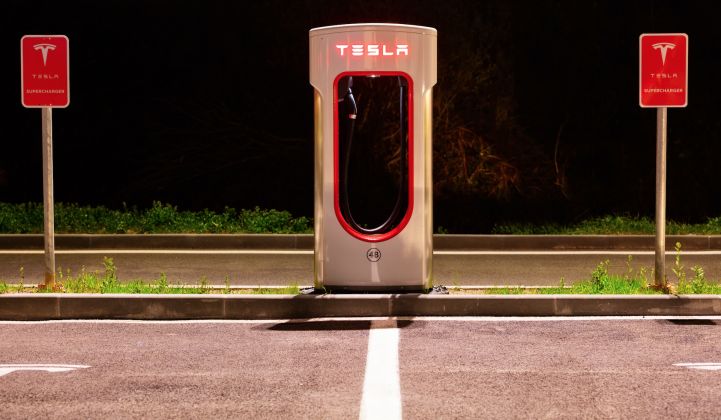Elon Musk is breaking out his bag of pixie dust this week. Or, wait -- maybe it's a portal gun.
At Tesla’s semi-truck unveiling, which will be live-streamed online this Thursday night, Musk said he plans to “blow your mind clear out of your skull and into an alternate dimension” using his “portal gun,” according to his latest tweet.
In that alternate dimension, Tesla’s difficulties -- its largest quarterly loss ever, its three-month Model 3 manufacturing delay, its propensity to spend a billion dollars a quarter, and the myriad other worrisome financial metrics for the electric-car maker -- are all swept away by the latest shiny object.
This dimension is a reality distortion field.
Tesla is facing one of the toughest times in its history, akin to when the company struggled to get the first Roadsters and the Model S cars to customers. But this is a much grander scale.
Much more is at risk for Tesla today. It has hundreds of thousands of Model 3 reservations, over 30,000 employees, substantial debt and a stock price highly dependent on hitting its aggressive timelines.
No wonder Musk, who’s been camping out on the roof of the Gigafactory in order to help figure out Model 3 manufacturing bottlenecks, is looking for a flashy distraction.
When Musk shows off the company’s long touted electric semi-truck, it'll no doubt be an impressive and sleek prototype. But it's just the latest Tesla product in a long line of partially baked ones.
Other such projects include the solar roof, the Buffalo-based solar factory, the Model Y, autopilot software, and Musk’s side gigs like the Boring Company, the Neuralink and the hyperloop. Why not throw a semi-truck in there for fun?
However, Tesla's bread and butter -- the Model 3 and its accompanying battery factory outside of Reno, Nevada -- are the most crucial projects to watch. They’ve sucked down much of the company's capital, and they’ll make up much of Tesla’s future revenue. The Model 3 and Gigafactory will make or break Tesla -- and they've both been facing some serious problems as of late.
Two weeks ago, Tesla revealed that it won’t be able to ramp up production of the Model 3 until late into the first quarter of 2018, a three-month delay. The company now expects to hit its goal of making 5,000 Model 3 cars per week by March of 2018, instead of late 2017.
According to Tesla, the delay was caused by equipment used to assemble battery cells into modules at the Gigafactory. Musk said a supplier “dropped the ball,” so the company brought the steps in-house and rewrote the software.
In an attempt to help fix some of these factory issues, last week Tesla acquired a factory automation company called Perbix, based in Minnesota, which has been a supplier to the company for almost three years. While the parties didn’t disclose the terms of the deal, Tesla said it was giving cash and stock to Perbix’s owner, including a little over $10 million in stock.
The deal won’t likely end Tesla’s “production hell.”
Musk described that hell as as a “level eight,” and “close to exiting level eight,” (presumably based on the nine levels of hell depicted in Dante’s Inferno). “I thought we could probably be more like a level seven by now, and I have to tell you, I was really depressed about three or four weeks ago when I realized that we're kind of in level nine. Then we got to level eight. Now I can see sort of a clear path to sunshine," said Musk on an earnings call.
The path isn't clear yet. Tesla will need to make 10,000 Model 3s soon. And then it will need to make 500,000 cars in 2018 (up from the 100,000 it will likely make this year), according to Musk's timeline. A large share of those cars are supposed to be Model 3s.
After an earnings call, analysts at Cowen and Company noted a change in tone: “[Tesla] Management had one of the longest pauses we have heard in recent earnings calls when asked if they would achieve 10,000 units of Model 3 production per week in 2018, which was the team’s rhetoric just 3 months ago.”
If the Model 3 problems aren’t fixed by the first quarter, Tesla’s financial position could worsen. To cover its ballooning capex and revenue loss, the company might need to raise even more money. Tesla’s been plowing $1 billion each quarter into Model 3 and Gigafactory tooling.
However, Tesla’s first corporate bonds are faring pretty badly, which could be an indicator that the company’s ability to consistently tap into public markets is starting to wane. Will the credit rating agencies downgrade Tesla as a result of the Model 3 issues?
Meanwhile, the company’s stock price is also down nearly 17 percent over the past three months, after gaining considerably earlier this year. A sudden loss of confidence and a cratering stock price can lead to disaster -- just look at SunEdison.
Institutional investors have been selling Tesla stock since earlier this year.
If Model 3 struggles start unraveling Tesla, other projects will also be in trouble. Tesla wants to start production of its solar roof by the end of the year, and reach full production by 2019. But are the Gigafactory issues a cautionary tale for manufacturing in Buffalo?
Tesla’s solar installation business, which it acquired from SolarCity, continues to install far fewer solar panels than it did as an independent business. Meanwhile, Powerwall battery delays are causing headaches too.
With all of these issues swirling around the company at once, who can really blame Musk for breaking out the portal gun to send us to another dimension?
Envisioning future products and designing a better world is the fun part. The hard part is delivering on so many products simultaneously.




